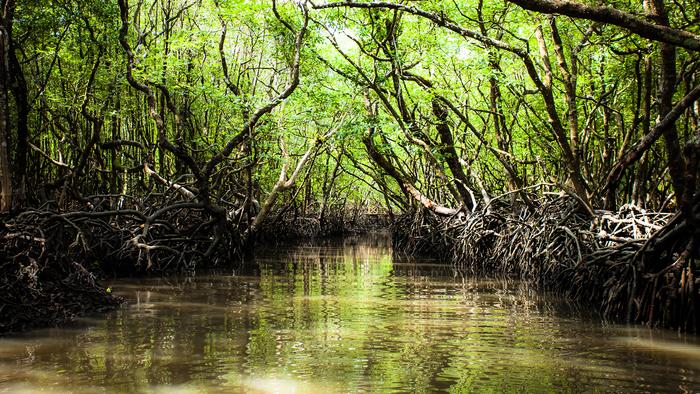The annual rate of carbon emissions due to the degradation of carbon stocks in mangrove forests is predicted to rise by nearly 50,000% by the end of the century, according to a new study published in IOP Publishing’s journal Environmental Research Letters. Mangroves in regions such as southern India, southeastern China, Singapore and eastern Australia are particularly affected.

Credit: IOP Publishing
The annual rate of carbon emissions due to the degradation of carbon stocks in mangrove forests is predicted to rise by nearly 50,000% by the end of the century, according to a new study published in IOP Publishing’s journal Environmental Research Letters. Mangroves in regions such as southern India, southeastern China, Singapore and eastern Australia are particularly affected.
Mangrove forests store a large amount of carbon, particularly in their soils, however human development in these areas has led to the degradation of these carbon stocks. Over the past 20 years, a substantial number of mangrove forests have been replaced by agriculture, aquaculture and urban land management, leading global mangrove carbon stocks to decline by 158.4 million tonnes – releasing the same level of carbon emissions as flying the entire US population from New York to London.
The study is led by Jennifer Krumins, Professor of Biology at Montclair State University, alongside two PhD candidates, Shih-Chieh Chien and Charles Knoble. The team focussed on the relationship between human population density and soil carbon stocks in urban mangrove forests to quantify their role in the global carbon budget.
The results show that when population density reaches 300 people/km2 (similar to the average population density of the UK or Japan), the carbon stored in mangrove soils near populated areas is estimated to be 37% lower than isolated mangrove forests. At the same time, the annual rate of carbon emissions from mangrove loss is currently estimated to be 7.0 Teragrams, rising in line with increased population density to 3,392 Teragrams by current predictions at the end of the century.
Mangrove forests cover approximately 0.1% of the Earth’s land surface but play a vital role in providing wildlife habitats and regulating global climate stability. These mangroves store a large amount of carbon, particularly in their soils, and are essential to regulating carbon cycling on a global scale. Mangrove soils contain three to four times the mass of carbon typically found in boreal, temperate, or tropical forests.
Professor Krumins says: “This work underscores the importance of protecting existing mangroves, especially in areas with high population density. Mangrove forests are critical to the regulation of carbon sequestration, and it is important that we protect them. The first step is to understand the impact of human populations and activities on mangrove forest carbon stocks.”
Journal
Environmental Research Letters
DOI
10.1088/1748-9326/ad13b6
Article Title
Human population density and blue carbon stocks in mangroves soils
COI Statement
The authors have declared no COIs.




